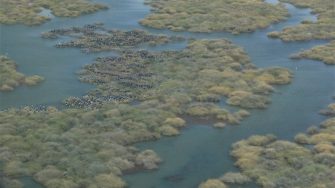
Date: Tuesday, October 13, 2020
Project: Eastern Australian Waterbird Survey
Observers: Richard Kingsford UNSW, Paul Wainwright DEWHA
Pilot: James Barkell NSW National Parks & Wildlife Service DPIE
Lovely morning in Broken Hill – perfect day for flying, not too hot and no wind. We headed back to our survey band and picked up a couple of small wetlands that must have just got rainfall because they were shallow and only had a few white-faced herons. But the country looked great, with streaks of green marking the creek lines.
We headed southwest to survey wetlands along the River Murray, south of Renmark, before heading east. There were surprisingly more waterbirds down on the small section of the river that we surveyed. We will see whether this stacks up when we survey the river comprehensively in a couple of weeks.
From here, we then surveyed evaporation ponds to the east of the river. These are where salt from the river is dumped. The evaporation ponds often have a lot of waterbirds but not as many this year, with probably no more than a few hundred waterbirds, mostly swans and teal.
We then headed east, past a solar farm that looked like a big wetland, to survey some highly salinised wetlands south of Mildura and east of the River Murray. They never have much water and few waterbirds. The water is too saline. They would have been highly productive freshwater swamps at some point. Then back on to the River Murray with only the odd cormorant.
We stopped in Balranald for a stretch and to change the gopro. And then headed up the western edge of the Murrumbidgee River floodplain to first survey Paika Lake, a freshwater lake drying back with not many waterbirds. We then headed north to another couple of other lakes, one of which was highly productive. You could see the clear water and aquatic plants growing on the bottom of the wetland, supporting hundreds of teal, pink-eared ducks and small flocks of glossy ibis.
From there, it was across the river to Piggery Lake and its surrounding Murrumbidgee floodplain. These systems really come alive with water. The water created wonderful patches of colour green and brown, marking where it had gone and the plants that it germinated. In among all these red gums, it is always hard to see the waterbirds but there were occasional glimpses of teal, egrets and the odd swan pair with a brood. The flooding was the result of a substantial watering program by the NSW and Commonwealth Governments.
From here we headed east to Lake Tala, a permanent freshwater lake, with only a few waterbirds, a big contrast to what was to come on the floodplain. Then it was onto the floodplain where there were hundreds of teal, whiskered terns, gull-billed terns, pied stilts and straw-necked ibis. There were also a few hardhead, Pacific herons and glossy ibis.
This was a result of the environmental flows coming through what is known as the Gayini wetlands, a wonderful restoration project of the extensive wetland system, managed by the Nari Nari Tribal Council and a Consortium of partners, including the The Nature Conservancy, Murray Darling Wetlands Working Group and our Centre for Ecosystem Science at UNSW. It is such a great part of the Murray-Darling Basin, with considerable promise, as long as the water can come down and flood and do its magic, brilliantly on display today. The patterns of flooding are mesmerising, intricate and ever changing in their paths and colours.
On the most eastern part of the floodplain, there was a large flooded wetland of lignum bushes. You always know when a wetland is really taking off when the colonial waterbirds arrive and start nesting. It was fabulous to see a small colony of a few thousand straw-necked ibis had established in the middle of the wetland. There were also a few white ibis breeding. When there is really widespread flooding, other colonies set up across the floodplain because there is so much food available. There can be tens of thousands of birds breeding.
Blog by Richard Kingsford
